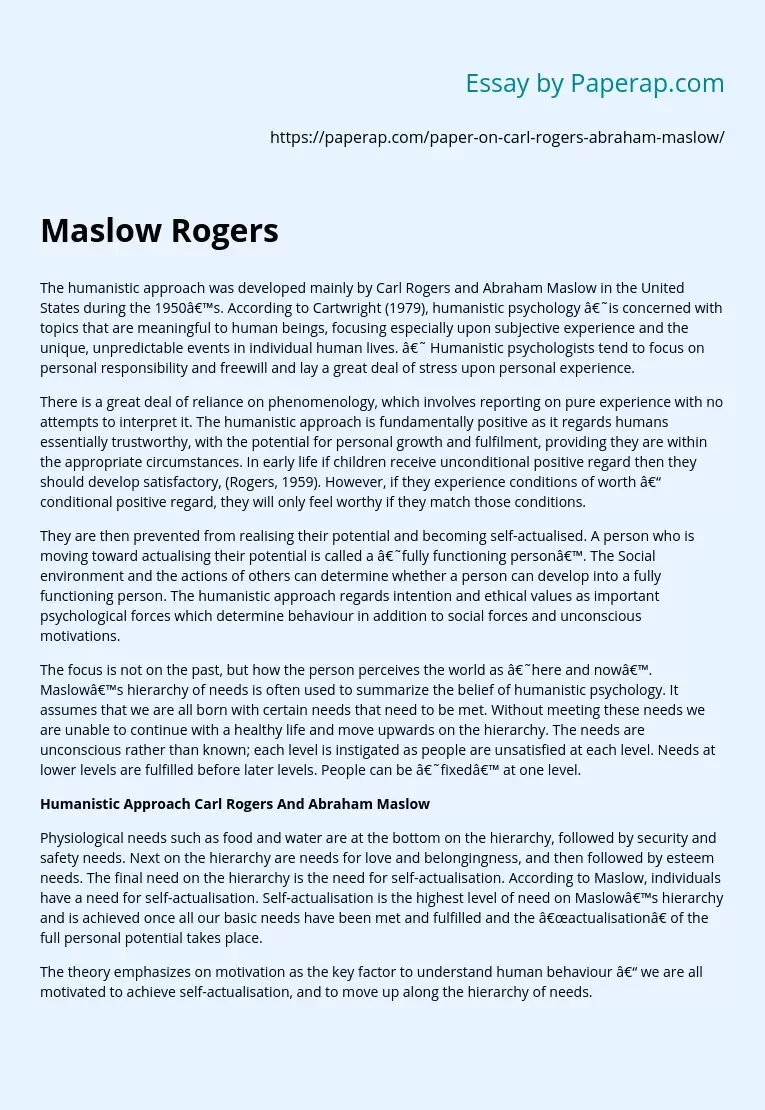Humanistic Approach Development in 1950s USA
The humanistic approach was developed mainly by Carl Rogers and Abraham Maslow in the United States during the 1950’s. According to Cartwright (1979), humanistic psychology ‘is concerned with topics that are meaningful to human beings, focusing especially upon subjective experience and the unique, unpredictable events in individual human lives. ‘ Humanistic psychologists tend to focus on personal responsibility and freewill and lay a great deal of stress upon personal experience.
There is a great deal of reliance on phenomenology, which involves reporting on pure experience with no attempts to interpret it.
The humanistic approach is fundamentally positive as it regards humans essentially trustworthy, with the potential for personal growth and fulfilment, providing they are within the appropriate circumstances. In early life if children receive unconditional positive regard then they should develop satisfactory, (Rogers, 1959). However, if they experience conditions of worth – conditional positive regard, they will only feel worthy if they match those conditions.
They are then prevented from realising their potential and becoming self-actualised.
A person who is moving toward actualising their potential is called a ‘fully functioning person’. The Social environment and the actions of others can determine whether a person can develop into a fully functioning person. The humanistic approach regards intention and ethical values as important psychological forces which determine behaviour in addition to social forces and unconscious motivations.
The focus is not on the past, but how the person perceives the world as ‘here and now’. Maslow’s hierarchy of needs is often used to summarize the belief of humanistic psychology.
It assumes that we are all born with certain needs that need to be met. Without meeting these needs we are unable to continue with a healthy life and move upwards on the hierarchy. The needs are unconscious rather than known; each level is instigated as people are unsatisfied at each level. Needs at lower levels are fulfilled before later levels. People can be ‘fixed’ at one level.
Humanistic Approach Carl Rogers And Abraham Maslow
Physiological needs such as food and water are at the bottom on the hierarchy, followed by security and safety needs. Next on the hierarchy are needs for love and belongingness, and then followed by esteem needs. The final need on the hierarchy is the need for self-actualisation. According to Maslow, individuals have a need for self-actualisation. Self-actualisation is the highest level of need on Maslow’s hierarchy and is achieved once all our basic needs have been met and fulfilled and the “actualisation” of the full personal potential takes place.
The theory emphasizes on motivation as the key factor to understand human behaviour – we are all motivated to achieve self-actualisation, and to move up along the hierarchy of needs. Maslow (1954) identified Abraham Lincoln and Albert Einstein as self-actualised individuals. Humanists disagree with Freud that the majority of who we are is buried in the unconscious, deep beyond our awareness. Maslow believed that we are aware of our needs and drives and without the obstacles of life we would all become psychologically healthy individuals with a deep understanding of ourselves and the world around us.
A key assumption with the humanistic approach is that unlike the determinist view of psychoanalytic theories, we very much have freewill and have the awareness and potential to change and develop. Carl Rogers developed a fundamental assumption of humanistic psychology with the idea of self-concept. He talked about healthy development in terms of how an individual perceives their own being. A healthy individual will tend to see congruence between their sense of who they are (self) and who they feel they should be (ideal).
While no one tends to experience perfect congruence at all times throughout their lives, the relative degree of congruence between the self and the ideal is seen as an indicator of health. The case I have chosen to try to understand from a humanistic approach is about Daniel the 35 year old salesman who has been experiencing acute pains in his chest. His GP has found no obvious physical symptoms of ill health; although Daniel is reluctant to acknowledge that his chest pain is linked to stress.
There are a number of issues that can be explored here using the humanistic approach to develop an understanding as to why Daniel is behaving in this way. Daniel has recently been through a divorce and has been living on his own since. An obvious assumption which can be made from the humanistic approach would be to suggest that since his divorce, Daniel’s love and belongingness needs may not be met sufficiently. Maslow would suggest that Daniel may be feeling much more aware of his loneliness since the absence of his partner.
These feelings of loneliness usually occur once our basic needs have been met and our needs for love and belongingness become much more important motivations of our behaviour. Without his partner, he may also be lacking the support and security he was use to, adding to the stress he now faces at work. A second key factor to understanding Daniels behaviour is linked to his work. He describes himself as being very stressed at work, even more so since he has been reallocated from a major project he was leading to take charge of a basic but demanding sales task.
Humanistic Approach Development in 1950s USA. (2019, Dec 05). Retrieved from https://paperap.com/paper-on-carl-rogers-abraham-maslow/

